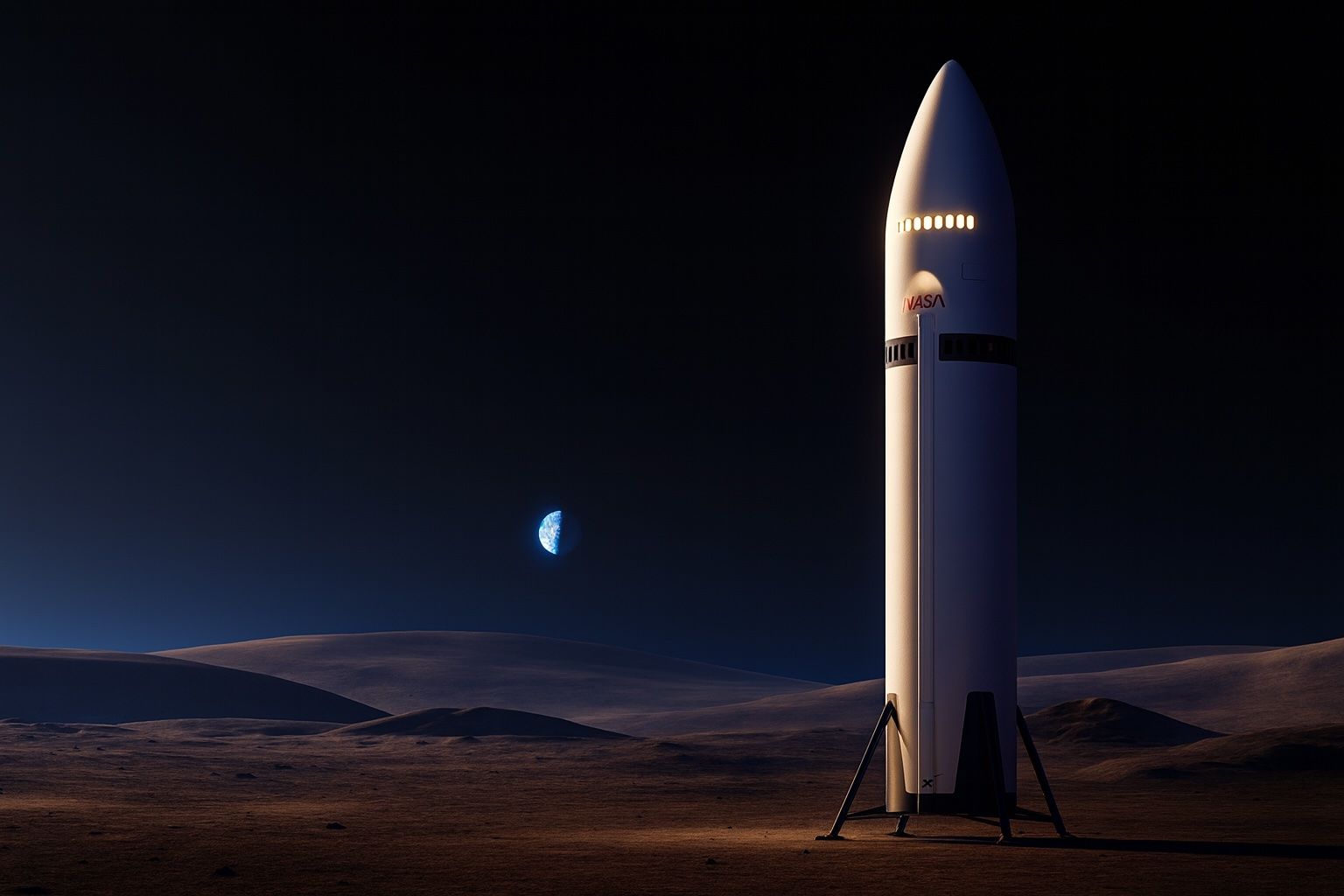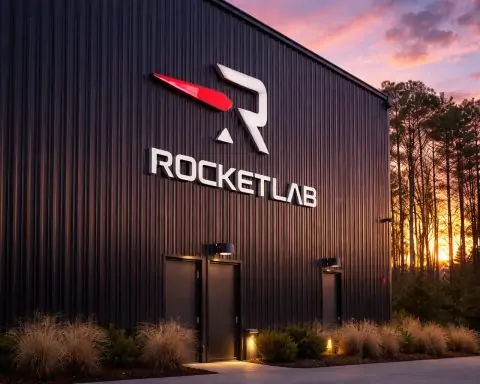- Artemis bid opens up: Acting NASA Administrator Sean Duffy announced on Oct. 20 that the agency will “open that contract up” for rivals (like Blue Origin/Lockheed) to build the Artemis III lunar lander, after SpaceX’s Starship delays [1].
- Starship test success: On Oct. 13 SpaceX flew Starship’s 11th prototype, reaching orbit and splashing down safely [2]. Duffy hailed it as “another major step toward landing Americans on the Moon’s south pole” [3] and SpaceX said its next versions will carry docking adapters and improved heat shields [4] [5].
- Race to the Moon: NASA still targets a crewed lunar landing by 2027 (Artemis III), whereas China is aiming to put taikonauts on the Moon by 2030 [6] [7]. China has even tested a new crewed lander “Lanyue” in August 2025 [8], and plans an International Lunar Research Station with Russia by the mid-2030s [9] [10].
- Expert warnings: Former NASA officials fear NASA’s current plan is risky. Ex-administrator Jim Bridenstine called Artemis’ architecture “extraordinarily complex” and doubted it would beat China to the Moon [11]. Ex-Program Chief Doug Loverro warned the goal is “incredibly hard, complex – likely a decade away” and said Starship “won’t be ready” before China [12] [13]. By contrast, some experts remain upbeat: MIT’s Olivier de Weck gave SpaceX’s recent Starship flight “an A-plus” and Phoenix Capital’s Greg Autry says SpaceX “is headed in the right direction” [14].
- Moon governance: Legal experts stress that all lunar activity must honor the Outer Space Treaty (1967), which forbids national sovereignty on celestial bodies. The U.S. is considering moves to reinforce this non-appropriation principle (e.g. through Congress and the UN) in case China plants a flag [15] [16]. Space economist Simonetta Di Pippo notes the Artemis Accords already recognize resource extraction “does not inherently constitute national appropriation” and urge “notification” and “coordination” among nations [17] [18]. In practice, experts say cooperation and treaties – not unilateral grabs – will be key to avoiding conflict on the Moon [19] [20].
- Space stock surge: Investors are riding the space boom. Tesla (TSLA), Elon Musk’s flagship, jumped over 5% in early October after record EV sales, trading in the mid-$400s and a roughly $1.5 trillion market cap [21]. Many analysts remain bullish (Morgan Stanley’s target ~$410, some bulls see $500–$600 [22]). Pure-play space stocks have also soared: Rocket Lab (RKLB) is +95% year-to-date near $50 [23] (analysts have “Strong Buy” ratings and ~$50–$60 targets). Even indirect plays like Amazon (AMZN, ~216 USD) jumped on space news, since its Bezos-backed Blue Origin could win the Artemis lander job [24]. Record funding flows (about $3.5 billion into space ventures in 2025 [25]) reflect growing confidence that lunar exploration will spawn new industries.
NASA’s Artemis Program and SpaceX’s Starship
NASA’s Artemis program is revving back up. After Artemis II (crewed lunar flyby) slips into 2026, the big prize is Artemis III – the first American moon landing since Apollo. Under the current plan, NASA will launch Orion atop an SLS rocket and then rendezvous with SpaceX’s Starship, which must carry astronauts from lunar orbit to the surface. SpaceX’s recent Flight 11 (Oct. 13) achieved most of its objectives: the Starship upper stage reached space and deployed payloads, while the Super-Heavy booster performed a soft water landing [26]. NASA’s acting chief Sean Duffy praised the mission as “another major step toward landing Americans on the Moon’s south pole” [27].
SpaceX says it will now fly an upgraded Starship prototype with key features for deep space – including orbital refueling hardware – likely by year’s end [28]. SpaceX President Gwynne Shotwell told reporters this new version “is really the vehicle that could take humans to the Moon and Mars” [29]. Elon Musk himself is pushing for starship refueling tests soon (which NASA had expected this year) [30]. These technologies are vital: dozens of tanker Starship flights will be needed to fuel a Moon-bound lander in orbit. NASA paid SpaceX over $3 billion in 2021 for Starship as the human lunar lander under Artemis, so delays are politically sensitive [31].
However, insiders warn NASA’s approach is far from certain. Former NASA manager Doug Loverro bluntly said reliance on Starship was “made in error” and warned the rocket “won’t be ready” to carry astronauts by 2027 [32]. A NASA safety panel also testified that Starship is “years late” for Artemis III [33]. Conversely, supporters argue the rapid pace of SpaceX’s development is unprecedented: engineer Olivier de Weck gave August’s Flight 10 “an A-plus” after it barely avoided an explosion, and noted the next hurdle is a controlled, upright landing [34]. Longtime Musk-critic-turned-bull Greg Autry points out that SpaceX “tends to prove critics wrong in the long run,” citing its past successes [35].
In short, Artemis III’s 2027 target is on NASA’s radar, but it may slip if Starship stumbles. NASA wants “competition” in the lunar program to hedge those risks. On Oct. 20, Duffy said he’s “opening that [Artemis III] contract up” to other bidders [36]. By reviving competition, companies like Jeff Bezos’s Blue Origin and Lockheed Martin can now vie for the first human moon lander mission. Blue Origin already has a $3.4B lander contract for Artemis V (2029), but could now try for an accelerated 2028/2029 Moon shot instead.
U.S.–China Moon Race: Timelines and Strategy
The Artemis program is often cast as a new Moon race against China. Beijing’s space agency has accelerated its lunar plans: in August 2025 China tested a Lanyue lander prototype, aiming to send astronauts to the Moon by 2030 [37]. China’s recent successes underline this urgency. Over the past five years, China launched Chang’e-5 (2020) and Chang’e-6 (2024) missions that made it the first nation to bring back lunar samples from both the near side and far side [38]. The Chinese and Russian space agencies are jointly planning the International Lunar Research Station (ILRS) by 2035, which would include a surface base and even a nuclear power reactor [39] [40].
U.S. officials don’t want to be outpaced. Congress and NASA have stressed landing by 2027, and President Trump insisted on returning before leaving office (2029). Duffy told Fox News: “I’ll be damned if the Chinese beat NASA or beat America back to the Moon. We are going to win the second space race” [41]. Republican Sen. Ted Cruz similarly warned that “drastic changes” to Artemis risked U.S. leadership in space [42]. In the current climate, even NASA’s once-sole Starship strategy is shifting to ensure some U.S. lunar landing happens on schedule.
International Moon Law and Conflict Prevention
A key issue in the U.S.–China Moon competition is legal authority. The 1967 Outer Space Treaty (signed by the U.S. and China alike) explicitly states that no nation may claim sovereignty over the Moon or other celestial bodies [43]. In practice, this means planting a flag or mining resources does not grant ownership. The Artemis Accords – a set of U.S.-led guidelines signed by 56 nations – uphold this and specify that resource extraction “does not inherently constitute national appropriation” [44]. They also call for “safety zones” around operations to prevent interference (though critics worry these zones might look like de facto claims [45]).
Despite treaties, some experts fear China will test these norms. Space-law attorney Michael Listner warns that Beijing’s assertive tactics in the South China Sea (like unfounded sovereignty claims in its “nine-dash line”) could be applied on the Moon [46]. He urges the U.S. to take preemptive diplomatic action: for example, Congress could officially reaffirm that the Apollo 11 flag plant did not create U.S. sovereignty (a principle embedded in Public Law 91-119), and the U.S. could sponsor a UN resolution re-asserting the non-sovereignty rule [47] [48]. In other words, experts say Washington should publicly remind the world (and China) that flags on the Moon are symbolic only, not land grabs.
Meanwhile, others stress cooperation. Simonetta Di Pippo (space economist at Bocconi University) points out that the upcoming Moon bases will coexist: China’s ILRS and NASA’s Artemis Base Camp (at the south pole) will eventually operate simultaneously [49]. She argues space can be “a platform for diplomacy as well as conflict” – citing that the new class of U.S. astronauts (60% women!) reflects an inclusive approach [50] [51]. Di Pippo notes many Artemis-signatory countries (e.g. Thailand, Senegal) are also part of China’s lunar program, potentially serving as bridges for cooperation. In her view, following existing treaties (like the seldom-used 1979 Moon Agreement) and possibly tweaking them will be more effective than duplicating old rivalries [52] [53]. Ultimately, she concludes, a “global effort” is mandatory: humans will all be “terrestrials” on the Moon regardless of flag, so the way forward is partnership, not cowboy tactics [54].
Space Economy: Stocks and Forecasts
The Artemis-Chinese Moon narrative has energized investors in the space sector. Although SpaceX itself is private, its CEO Elon Musk exerts huge market influence. Tesla (NASDAQ: TSLA) stock – often seen as Musk’s flagship – surged in early October on record EV deliveries and enthusiasm for the space agenda [55]. TSLA briefly traded in the mid-$450s (a ~$1.5 trillion market cap) [56]. Wall Street is divided: one analyst’s $410 price target [57] implies some risk, but many bulls cite Musk’s track record and foresee $500–$600 if growth continues [58]. (Tesla trades at a stratospheric ~250× earnings, so any slip in delivery momentum is watched carefully [59].)
Beyond Tesla, dedicated space companies have also seen jumps. Rocket Lab (NASDAQ: RKLB), a small launcher, is nearly double its January price, trading around $50 [60]. Its share rise reflects a packed manifest (over 20 launches planned in 2025) and big contracts (e.g. building satellites for Japan and NASA) [61]. Analysts rate RKLB a Strong Buy with targets near $50–$60 [62], though they caution the stock’s valuation (50–60× sales) is very high.
Investors can also get indirect space exposure via larger stocks. Boeing (NYSE: BA) – which builds NASA’s SLS rockets and runs ISS operations – hovers in the low-$200s per share after years of program delays. (Analysts expect Boeing’s recent Artemis delays to shave ~$4 billion from 2025 revenue [63], though this has yet to move the market sharply.) Lockheed Martin (NYSE: LMT, ~$490/share) also stands to benefit from Orion and other space contracts announced late 2024. And Amazon (NASDAQ: AMZN), now around $216 [64], is watched as Blue Origin’s deep-pocketed parent: forecasts see Amazon returning to the low-$200s but growing by 2026 [65].
Overall, analysts say space is the next tech frontier. A recent report notes $3.5 billion invested in space ventures in 2025 – a record pace [66]. Wall Street sees a future where satellite broadband, lunar mining, even space tourism can generate returns. But for now the spotlight is on the Moon: as one TS2.Tech analysis puts it, “the outcome of this giant rocket’s next hop could steer the future of lunar exploration and the space industry for the next decade” [67].
Sources: Reporting by Reuters, SpaceNews opinion pieces, and expert coverage (e.g. Phys.org/The Conversation and SpaceTech analysts) [68] [69] [70] [71] [72]. Stock data (TSLA, RKLB, AMZN, etc.) is current as of late Oct. 2025 [73] [74]. Expert quotes and forecasts are cited above.
References
1. www.reuters.com, 2. www.reuters.com, 3. www.reuters.com, 4. www.reuters.com, 5. www.reuters.com, 6. www.reuters.com, 7. www.reuters.com, 8. www.reuters.com, 9. www.reuters.com, 10. phys.org, 11. ts2.tech, 12. ts2.tech, 13. ts2.tech, 14. ts2.tech, 15. starfightersspace.com, 16. phys.org, 17. phys.org, 18. phys.org, 19. phys.org, 20. phys.org, 21. ts2.tech, 22. ts2.tech, 23. ts2.tech, 24. ts2.tech, 25. ts2.tech, 26. www.reuters.com, 27. www.reuters.com, 28. www.reuters.com, 29. www.reuters.com, 30. www.reuters.com, 31. www.reuters.com, 32. ts2.tech, 33. ts2.tech, 34. ts2.tech, 35. ts2.tech, 36. www.reuters.com, 37. www.reuters.com, 38. www.reuters.com, 39. www.reuters.com, 40. phys.org, 41. ts2.tech, 42. ts2.tech, 43. phys.org, 44. phys.org, 45. phys.org, 46. starfightersspace.com, 47. starfightersspace.com, 48. starfightersspace.com, 49. phys.org, 50. phys.org, 51. phys.org, 52. phys.org, 53. phys.org, 54. phys.org, 55. ts2.tech, 56. ts2.tech, 57. ts2.tech, 58. ts2.tech, 59. ts2.tech, 60. ts2.tech, 61. ts2.tech, 62. ts2.tech, 63. www.nasdaq.com, 64. ts2.tech, 65. ts2.tech, 66. ts2.tech, 67. ts2.tech, 68. www.reuters.com, 69. www.reuters.com, 70. starfightersspace.com, 71. ts2.tech, 72. ts2.tech, 73. ts2.tech, 74. ts2.tech










